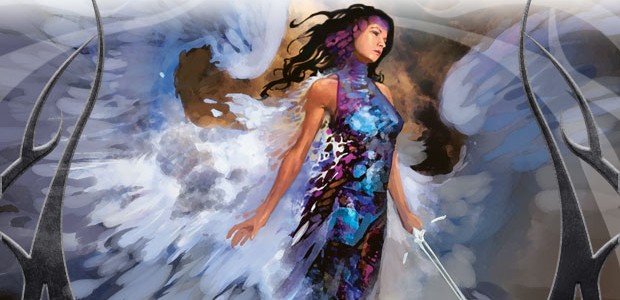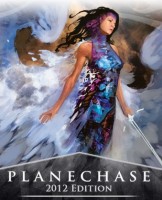
Magic: the Gathering is all about powerful magi, known as planeswalkers, fighting it out over the different planes of the multiverse. Planechase is a multiplayer tool designed to allow players to feel the effect of the plane they are currently on. Does it work, find out after the jump. . .

MAGIC: THE GATHERING PLANECHASE 2012
Initial Concept and Game Design: Mark Globus (lead), Kelly Digges, Dave Guskin, and Ryan Miller
Final Game Design and Deck Development: Mark L. Gottlieb (lead), Ryan Miller, Lee Sharpe, and Ken Troop, with contributions from Matt Tabak
Publisher: Wizards of the Coast
Price: $19.99
Previously in Planechase:The first Planechase decks and cards came out in 2009 with four different decks each including a 60 card deck of reprints and a 10 card planar deck of the new plane cards designed to be used with the 60 card decks. You can find the rules here. These were alright, but the two decks didn’t always play well together and there weren’t always the best choices for themes in the normal decks. This time around, Wizards has taken a step in a new direction.
THE SIMILAR
Planechase is designed to give the players the feeling of traversing the planes while battling other planeswalkers, and that it does rather well. The planar decks consist of ten cards representing different planes in the multiverse, and each has two effects on game play. The first is a mostly static ability (static abilities in Magic are ones that are in constant effect) such as: all creatures get +1/+1 or all instants and sorceries have rebound, though some can be triggered instead (happen at a specific event) such as: Scry 4 when you planeswalk to it or at the beginning of the upkeep or whenever a creature enters the battlefield it gets doublestrike and haste until end of turn. The second deals with the Plancechase die. The six-sided die has two things printed on, a planeswalker symbol and a chaos symbol. The chaos symbol causes different things to happen on the different planes, usually coinciding with what the plane does normally, such as the Scry plane letting you play the top card of your library for free.
For the four decks in Planechase 2012, each comes with a ten card planar deck and a total of 32 new planes. The new planar decks are paired with decks that follow themes based on popular keyword mechanics that are not likely to be coming back soon: cascade, totem armor, devour, and, my favorite, ninjutsu. These decks follow logical paths for what they do, such as tokens in the devour deck and cheap evasion creatures for ninjutsu, and as such look to be solid casual decks that will be fun to manipulate to our own ends.
THE CHANGED
This time around, on top of the new planar cards, we are also getting new normal cards, one copy of an essentially Planechase only card in each deck, and then half a dozen new cards tailored to each deck. We also get a new planar card type, the phenomenon. The phenomenon are show up while planeswalking and give a quick effect before you move on and are there to add a little more variety to the planar decks, and they work.
The much cooler change is the new cards tailored to each deck. Two new cascade spells, some new ninjas, more totem armor, and more give each deck an identity outside of any other Magic product. Of course, keeping with the success of last year’s Commander set we get even more love, as each deck has a new multicolor legend that is perfect for the commander format. Between the new planar cards and the new cards in general Planechase 2012 is shaping up to be vastly superior to the original, but most importantly, how do they play.
GAMEPLAY
I and my friend Walter picked up two of the four decks, Chaos Reigns and Night of the Ninja (decklists for all four) and tried them out. Despite an opening advantage on my part, he did win, but they were fun. The planar decks felt like they matched the themes and ideas behind the decks they were included in a lot more, and the decks themselves had better ideas going into them as well. For example, the ninja deck has small, evasive creatures to get your ninjas going, and the planar deck to go with it uses mostly creature based triggers like combat damage or leaving the battlefield. The phenomena also make for an interesting addition to the format, making things just a touch more random without forcing the randomness to stick around.
BOTTOM LINE: QUITE FUN
After my disappointment with the last Planechase set I wasn’t exactly looking forward to a new one, but when Wizards announced the new cards and themes, I decided to give them a chance and they managed to prove my worries wrong. With new cards, new ideas, and cohesive themes throughout, Planechase 2012 gets 4.5 out of 5 stars as the latest addition to Magic.




2 Comments
Oh so thats what this big card that gave me a few weeks ago at a Magic Tourament is for. I got a Plane – Xerex (Stairs to Infinity) card. My son and I have just started in to MTG (me for the 2nd time) and I do have one question. –
Knowing we will need to get at least 2 of the starter decks, I was worndering if you can use your normal decks with this system?
Yes, you can use your own decks with the plane cards. The only difference will be that the plane decks included in each pack are designed to synergize with their respective companion decks. However, you may find that the format can still be just as much, if not more, fun with any random deck you have laying around. You can even use things like Commander decks (99 cards with the same colours as its one always-cast-able legendary creature as a ‘general’ with no repeats except basic lands) and meld the two formats together.